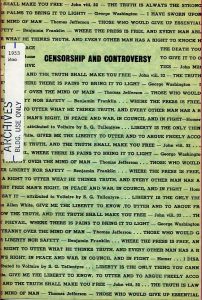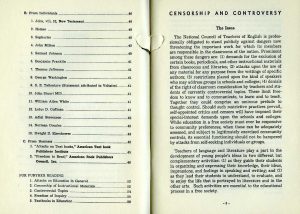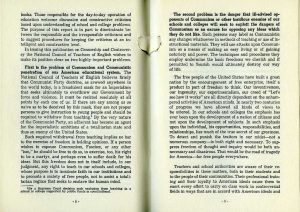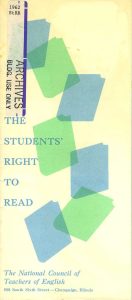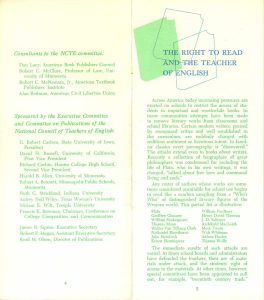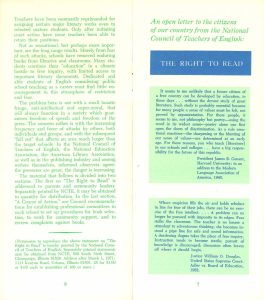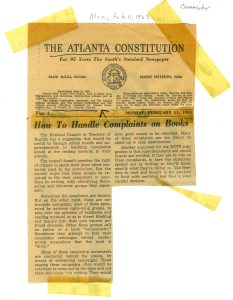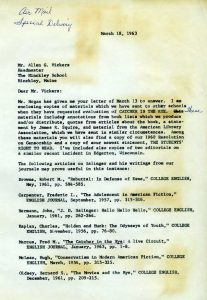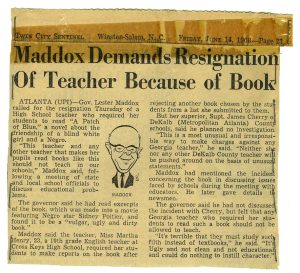“The techniques and procedures they employ undermine the basic freedoms we cherish and if permitted to flourish would ultimately destroy our way of life.”
From Censorship and Controversy, prepared by NCTE’s Committee on Censorship of Teaching
When NCTE first formed, advocacy against censorship was not a significant part of the Council’s activities. Instead, NCTE was largely occupied with improving the workload of English teachers, setting standards in English instruction, and promoting reasonable college entrance requirements.
However, censorship became a central issue in the 1950s, with McCarthyism spurring the NCTE to take a more active stance against the issue. In 1953, NCTE’s Committee on Censorship of Teaching Materials published Censorship and Controversy, which condemned McCarthy’s tactics and championed freedom of thought.
Although McCarthyism soon died away, the NCTE continued to rally against book bannings, with several committees dedicated to working against this suppression around the country, including the Committee Against Censorship, the Committee to Report Case Studies on Censorship, and the NCTE Task Force on Guidelines for Dealing with Censorship of Nonprint Materials. The Council also began to focus more on emphasizing the rights of students. In 1962, The Students’ Right to Read, published by the NCTE, defends both the rights of teachers and students the freedom to select what to read.
Today, NCTE actively supports teachers facing censorship by offering resources through its online Anti-Censorship Center. To learn more about anti-censorship in NCTE’s past, take a look at the featured topics below:
- Censorship and Controversy
- The Student’s Right to Read
- NCTE Defends Teachers: “How to Handle Complaints on Books”
- The Catcher in the Rye Controversy
- English Teachers Under Pressure: “Maddox Demands Resignation”
- Meeting Censorship in the School: A Series of Case Studies
Censorship and Controversy
The first NCTE publication to decry censorship, Censorship and Controversy is a 56-page pamphlet prepared by the Committee on Censorship of Teaching Materials. Education specialist at the United States Office of Education, William R. Wood, chaired this committee, and five past presidents of NCTE served as members. In this pamphlet, they encouraged open-access to educational materials, as well as warned about people who would exploit the dangers of Communism to gain personal power. Learn more: 15/73/803
Item: Copy of Censorship and Controversy (1953)
The Student’s Right to Read
In 1962, the NCTE published The Student’s Right to Read to offer guidance to teachers on what to do if they faced potential censorship and to affirm the right of students and teachers to choose what to read. It sold over 150,000 copies, and NCTE continued to reprint and update the The Student’s Right to Read over the years, including printing a 1972 edition and a 1996 edition. It also serves as the basis for NCTE’s policy against censorship. Learn more: 15/71/824
Item: First printing of The Student’s Right to Read (1962)
NCTE Defends Teachers
The NCTE reached out to teachers through newspapers, informing educators on how to handle complaints. In an article in The Atlanta Constitution, the NCTE suggests: “The Council doesn’t question the right of citizens to speak their piece about materials used in the curriculum. But the Council urges that these people be required to file their complaints or questions in writing, fully identifying themselves and whatever groups they represent.” Many of the arguments NCTE presents here are based on the pamphlet, The Student’s Right to Read (see above). Learn more: 15/73/009
Item: “How to Handle Complaints on Books,” The Atlanta Constitution (February 11. 1963)
Controversy: The Catcher in the Rye
The NCTE would also directly aid teachers facing potential censorship. Unfortunately, the Council was not always successful. In this series of correspondence, the NCTE offers advice to a headmaster whose high school’s curriculum for juniors included the book, The Catcher in the Rye. Running into “rumbling” at the school, the headmaster asks for supporting documentation justifying the book’s intellectual value for an upcoming executive board meeting. In the end, however, the executive committee determined that “such a book as this has no place in the curriculum.” Learn more: 15/73/009
Item: Letters on Catcher in the Rye (1963)
English Teachers Under Pressure
The Council also collected newspaper clippings spanning decades, documenting cases of censorship against teachers. In this particular case, the governor of Georgia demanded the resignation of Martha Henry, a 23-year-old English teacher, for assigning A Patch of Blue to read. The governor charged that it was a “vulgar, ugly, and dirty book.” Fortunately, Henry had the support of her superintendent, who stated: “Neither she nor any other DeKalb County teacher will be pushed around on the basis of unusual statements.” Learn more: 15/73/009
Item: “Maddox Demands Resignation of Teacher Because of Book,” Twin City Sentinel (June 14, 1968)
Meeting Censorship in the School
In 1966, NCTE published Meeting Censorship in the School: A Series of Case Studies. The book was written by the Committee to Report Case Studies on Censorship, chaired by John Hove. The book examines nine case studies of schools that banned books, including The Catcher in the Rye. By analyzing the process through which books are banned – what was objectionable? why did this particular school district object to it? what is the surrounding community like? – the Council hoped it could better combat challenges to books. Learn more: 15/73/803
Item: Copy of Meeting Censorship in the School: A Series of Case Studies(1966)
